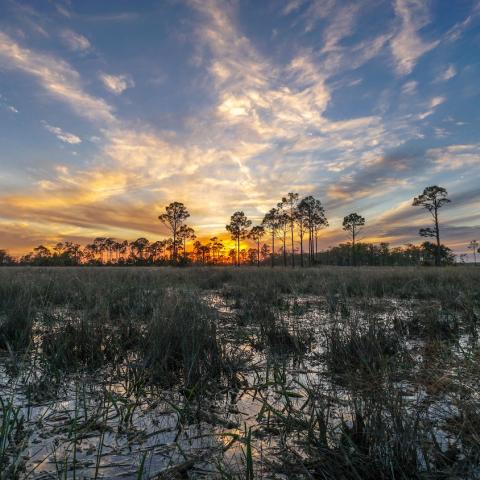
The U.S. Fish and Wildlife Service has changed the status of the red-cockaded woodpecker to "threatened" from "endangered."/USFWS
A decision by the U.S. Fish and Wildlife Service to downlist the red-cockaded woodpecker from being endangered to threatened has been criticized as being premature and ignorant of climate-change threats to the species.
Interior Secretary Deb Haaland called the decision Thursday "a significant milestone in our nation's commitment to preserving biodiversity,” Defenders of Wildlife called it ironic in light of hurricanes Helene and Milton that impacted habitat used by the bird.
The woodpecker, slightly larger than a Robin, once could be found from New Jersey to Florida and west into Texas and Missouri. It was listed as endangered in 1973, the same year Congress passed the Endangered Species Act, due to habitat loss. Today the species' population is defined by the Fish and Wildlife Service as roughly 7,800 "clusters," which include a breeding pair that is supported by up to six "non-breeding adult helpers," ranging from southern Virginia south to Florida and west into Texas.
The bird got its name from a streak of red feathers on the head of male woodpeckers.
National parks known to have the woodpeckers include Big Cypress National Preserve in Florida, Big Thicket National Preserve in Texas, and Cumberland Island National Seashore in Georgia. Parks that once could count the birds include Cumberland Gap National Historical Park in Tennesse, Virginia, and Kentucky; Great Smoky Mountains National Park in Tennessee; Everglades National Park in Florida; Big Southfork National River and Recreation Area in Tennessee and Kentucky and; Congaree National Park in South Carolina.
A release from Interior said the decision to downlist the species "is the result of five decades of collaborative conservation efforts between the Interior Department, federal and state partners, tribes, the private sector and private landowners that have resulted in increasing populations of these remarkable birds throughout their range."
According to the department, "state-wide Safe Harbor Agreements have enrolled 459 non-federal landowners covering approximately 2.5 million acres, resulting in an increase in red-cockaded clusters on private lands over the past three decades."
“Decades of committed recovery work and collaboration drove this remarkable story of recovery. The Service worked closely with the Departments of Agriculture and Defense, private landowners, Tribes, state agencies, businesses, utilities and conservation groups to reach today’s announcement,” said Fish and Wildlife Service Director Martha Williams. “The improved status of the red-cockaded woodpecker shows that when we give species a chance, they can thrive. The Endangered Species Act can serve as a catalyst for collaborative efforts like this one to promote recovery and conserve habitats.”
But Defenders said the announcement was "ironic" as it comes "in the wake of one of the largest and most destructive storms to hit the Southeast in recorded history, fracturing crucial connections between red-cockaded woodpecker habitats. Decades of significant progress have been made to recover this species and manage habitats effectively — progress which could now be upended at a critical time.”
Three years ago the Southern Environmental Law Center, along with Defenders, wrote the Biden administration to ask that it stop work to remove ESA protections from the woodpecker. In the letter the groups warned that "a variety of climate change impacts threaten the species—including increasingly frequent and more severe storm events," as well as loss of habitat to warming temperatures. [The letter is attached below]
On Thursday the wildlife advocacy group said that "[T]he species has faced significant habitat loss due to warming temperatures, including the recent destructive force of both Hurricane Helene and Hurricane Milton. Helene made landfall 70 miles from Apalachicola National Forest, home to important red-cockaded woodpecker populations. As few as 7,800 red-cockaded woodpeckers remain in pine forests across the south, with the majority of the species’ habitat eliminated by the logging industry. While some populations are doing well today, they are often isolated, leaving them vulnerable to large-scale disturbance."
Defenders also claimed that none of the downlisting criteria established for the species in 2003 by Fish and Wildlife has been fully met.
The Fish and Wildlife Service press release said the agency has "finalized a 4(d) rule to provide for the conservation of the species. The 4(d) rule continues the same prohibitions for red-cockaded woodpeckers as an endangered species, includes exceptions for routine law enforcement activities and habitat management and provides species-specific exceptions for beneficial management practices. The prohibitions apply throughout the species’ range, on both public and private lands."




 Support Essential Coverage of Essential Places
Support Essential Coverage of Essential Places






